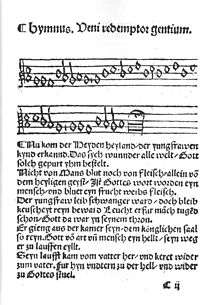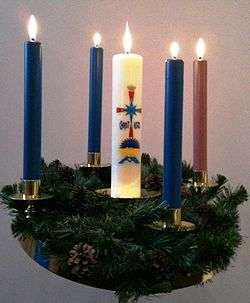Nun komm, der Heiden Heiland
"Nun komm, der Heiden Heiland" (original: "Nu kom der Heyden heyland", English: "Savior of the nations, come", literally: Now come, Saviour of the heathen) is a Lutheran chorale of 1524 with words written by Martin Luther, based on "Veni redemptor gentium" by Ambrose, and a melody, Zahn 1174, based on its plainchant. It was printed in the Erfurt Enchiridion of 1524.
| "Nun komm, der Heiden Heiland" | |
|---|---|
| Hymn by Martin Luther | |
 "Nu kom der Heyden heyland" in the Erfurt Enchiridion | |
| English | "Savior of the nations, come" |
| Catalogue | Zahn 1174 |
| Occasion | Advent |
| Text | by Martin Luther |
| Language | German |
| Based on | Veni redemptor gentium |
| Published | 1524 |
The song was the prominent hymn for the first Sunday of Advent for centuries. It was used widely in organ settings by Protestant Baroque composers, most notably Johann Sebastian Bach, who also composed two church cantatas beginning with the hymn. Later settings include works by Max Reger, Brian Easdale and Siegfried Strohbach.
English versions include "Savior of the nations, come" by William Morton Reynolds, published in 1851.
History
Martin Luther wrote the text of "Nun komm, der Heiden Heiland" possibly for the Advent of 1523 as a paraphrase of a passage, Veni redemptor gentium,[1] from the Latin Christmas hymn "Intende qui reges Israel" by Ambrose.[2][3] Several Latin versions begin with "Veni redemptor gentium", in similarity to hymns such as "Veni Creator Spiritus".[4] The themes from the 4th century are the humanity and divinity of Christ, as testified by his birth by the Virgin Mary.[5] Luther wrote the hymn at the end of 1523 in a period when he wrote many hymn texts, mostly psalm paraphrases and some free poems, such as "Nun freut euch, lieben Christen g'mein".[6] He paraphrased the seven stanzas of the Latin hymn rather closely, and added a doxology as an eighth stanza.[7] He seems to have been more interested in keeping the traditional text than fluent German, possibly to demonstrate his closeness to the traditional theology, in contrast to a translation by Thomas Müntzer, who followed his own theology.[6]
The melody, Zahn 1174,[8] was composed by Luther and possibly Johann Walter, based on the original plainchant melodies,[1][9] such as a 12th-century version from Einsiedeln.[10] The hymn was printed in the Erfurt Enchiridion in 1524, and was also published the same year in Walter's choral Wittenberg hymnal, Eyn geystlich Gesangk Buchleyn.[2][11] In several hymnals, the hymn opens the collection, such as Klug's Gesangbuch (1529 and 1533), the Babstsches Gesangbuch (1545),[12] and continuing to the Evangelisches Kirchengesangbuch (EKG)[3] of 1950, which retained five of the eight stanzas. In other hymnals, the hymn opened the section related to the liturgical year, such as in Johann Crüger's Praxis Pietatis Melica.[12] In the 1995 Evangelisches Gesangbuch it is EG 4, again in five stanzas.[2]
Theme and text
The song, in eight stanzas of four lines each, expresses first the request for the coming of a redeemer of all people, including the heathens or gentiles, born of a virgin. It reflects his origin from the Father, to whom he will return after going to Hell. The last stanza is a doxology, translating a medieval appendix to Ambrose's hymn.[13] The following shows the Latin original, the five stanzas by Luther contained in the 1995 Evangelisches Gesangbuch, and an English translation by William Morton Reynolds, "Savior of the nations, come", published in 1851.[14]
| Ambrose | Luther | Reynolds |
|---|---|---|
Veni, redemptor gentium; |
1. Nun komm, der Heiden Heiland, |
1. Savior of the nations, come; |
Melody and musical settings
Luther derived the melody from the Latin hymn's medieval plainchant melodies,[1][9] making changes to accommodate the more accented German. His major achievement was to repeat the first melodic line in the last, forming an ABCA structure and transforming the medieval hymn into a Lutheran chorale.[1]

The chorale was used as the prominent hymn for the first Sunday of Advent for centuries.[10] It was used widely in organ settings by Protestant Baroque composers,[15] most notably Johann Sebastian Bach, who set it as the opening chorale prelude (BWV 599) of the Orgelbüchlein and three times—as BWV 659 (one of his best known organ compositions), BWV 660 and BWV 661—in his Great Eighteen Chorale Preludes. Bach used the hymn in two church cantatas for the first Sunday of Advent, his chorale cantata Nun komm, der Heiden Heiland, BWV 62 (1724)[16] and in the opening chorale fantasia of his earlier cantata Nun komm, der Heiden Heiland, BWV 61 (1714).[17] Max Reger composed a setting as No. 29 of his 52 Chorale Preludes, Op. 67 in 1902.[18]
"Nun komm, der Heiden Heiland" continues to be used in modern settings. It appears in liturgically oriented Christian hymnals, for example the Lutheran Book of Worship, and as the cantus firmus for organ compositions. In Brian Easdale's score for the 1948 film The Red Shoes, the melody from the chorale is heard as a theme late in the ballet, punctuated by ringing bells, brass instruments and a grand piano. Siegfried Strohbach composed a choral setting in 1988.[19]
References
Citations
- Leaver 2017, p. 200.
- Marti 2000, p. 3.
- Bach Cantatas Website text.
- Marti 2000, p. 4.
- Marti 2000, pp. 4–5.
- Marti 2000, p. 6.
- Marti 2000, pp. 5–6.
- Zahn 1889.
- Marti 2000, p. 10.
- FAZ 2012.
- Hymnary 2018.
- Marti 2000, p. 7.
- Marti 2000, pp. 3–7.
- Hymns and Carol 2018.
- Bach Cantatas Website chorale.
- Bach Digital BWV 62.
- Bach Digital BWV 61.
- Institute 2017.
- Musicanet 2019.
Cited sources
- Books
- Leaver, Robin A. (2017). Luther's Liturgical Music: Principles and Implications. Fortress Press. pp. 200–201. ISBN 978-1-50-642716-4.CS1 maint: ref=harv (link)
- Marti, Andreas (2000). Hahn, Gerhard (ed.). 4 Nun komm, der Heiden Heiland. Liederkunde zum Evangelischen Gesangbuch (in German). Vandenhoeck & Ruprecht. pp. 3–7. ISBN 978-3-52-550335-5.CS1 maint: ref=harv (link)
- Zahn, Johannes (1889). Die Melodien der deutschen evangelischen Kirchenlieder (in German). I. Gütersloh: Bertelsmann. p. 314.
- Online sources
- "Chorale Melodies used in Bach's Vocal Works / Nun komm, der Heiden Heiland". Bach Cantatas Website. 2006. Retrieved 13 December 2018.
- "Nun komm, der Heiden Heiland / Text and Translation of Chorale". Bach Cantatas Website. 2005. Retrieved 13 December 2018.
- "Nun komm, der Heiden Heiland BWV 61; BC A 1 / Sacred cantata (1st Sunday of Advent)". Bach Digital. 2018. Retrieved 13 December 2018.
- "Nun komm, der Heiden Heiland BWV 62; BC A 2 / Chorale cantata (1st Sunday of Advent)". Bach Digital. 2018. Retrieved 13 December 2018.
- "Weihnachtslieder 2012 (16) / "Nun komm, der Heiden Heiland"". FAZ (in German). 16 December 2012. Retrieved 13 December 2018.
- "Nun komm, der Heiden Heiland". hymnary.org. 15 February 2017. Check date values in:
|year= / |date= mismatch(help) - "Savior Of The Nations, Come". hymnsandcarolsofchristmas.com. 2018. Retrieved 13 December 2018.
- "Zweiundfünfzig leicht ausführbare Vorspiele zu den gebräuchlichsten evangelischen Chorälen Op. 67 / für Orgel". Max-Reger-Institute (in German). 2017. Retrieved 13 December 2018.
- "Nun komm, der Heiden Heiland (1988)". musicanet.org (in French). 2019. Retrieved 30 March 2019.
External links
| Wikimedia Commons has media related to Nun komm, der Heiden Heiland. |
| German Wikisource has original text related to this article: |
- Nun komm, der Heiden Heiland, BWV 61 (Bach, Johann Sebastian): Scores at the International Music Score Library Project (IMSLP)
- Nun komm, der Heiden Heiland, BWV 62 (Bach, Johann Sebastian): Scores at the International Music Score Library Project (IMSLP)
- Nun komm, der Heiden Heiland: Free scores at the Choral Public Domain Library (ChoralWiki)
- Luke Dahn: BWV 62.6 bach-chorales.com
- Nun komm der Heiden Heiland – a set of chorale preludes the-bookhound.blogspot.com 12 December 2005
- Heinz Jansen: Nun komm, der Heiden Heiland (in German) Protestant Church in Baden
- Christopher J. Neuendorf: Savior of the Nations, Come lutheranchoralebook.com 2016
- C. Michael Hawn: History of Hymns: “Savior of the Nations, Come” umcdiscipleship.org
- Joachim Grabinski: Intende qui regis Israel / Veni redemptor gentium / Nun komm, der Heiden Heiland (in German) grabinski-online.de
- Fritz Wagner: 'Veni redemptor gentium'- Ein Weihnachtshymnus des Ambrosius von Mailand. (in German) In: Pegasus 3 / 2002, 1.
- Savior of the Nations, Come (mp3 with organ only)
